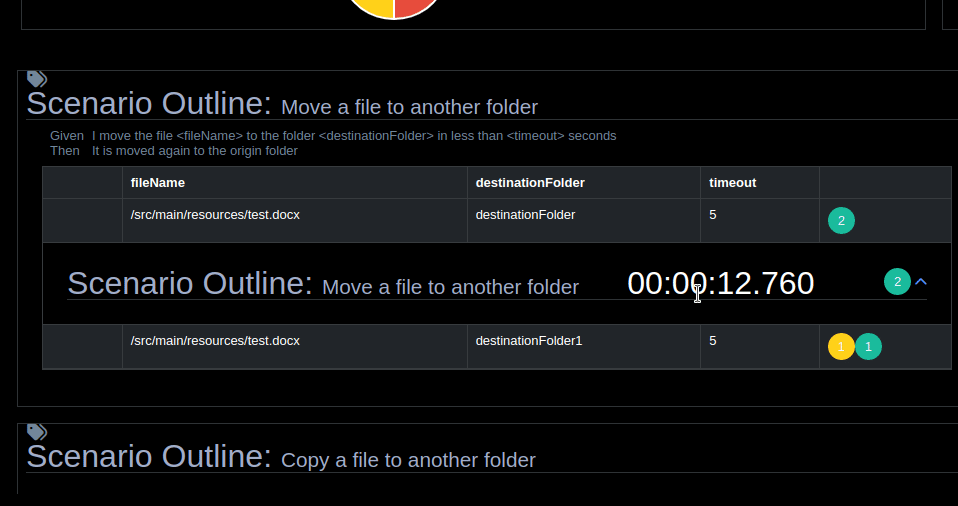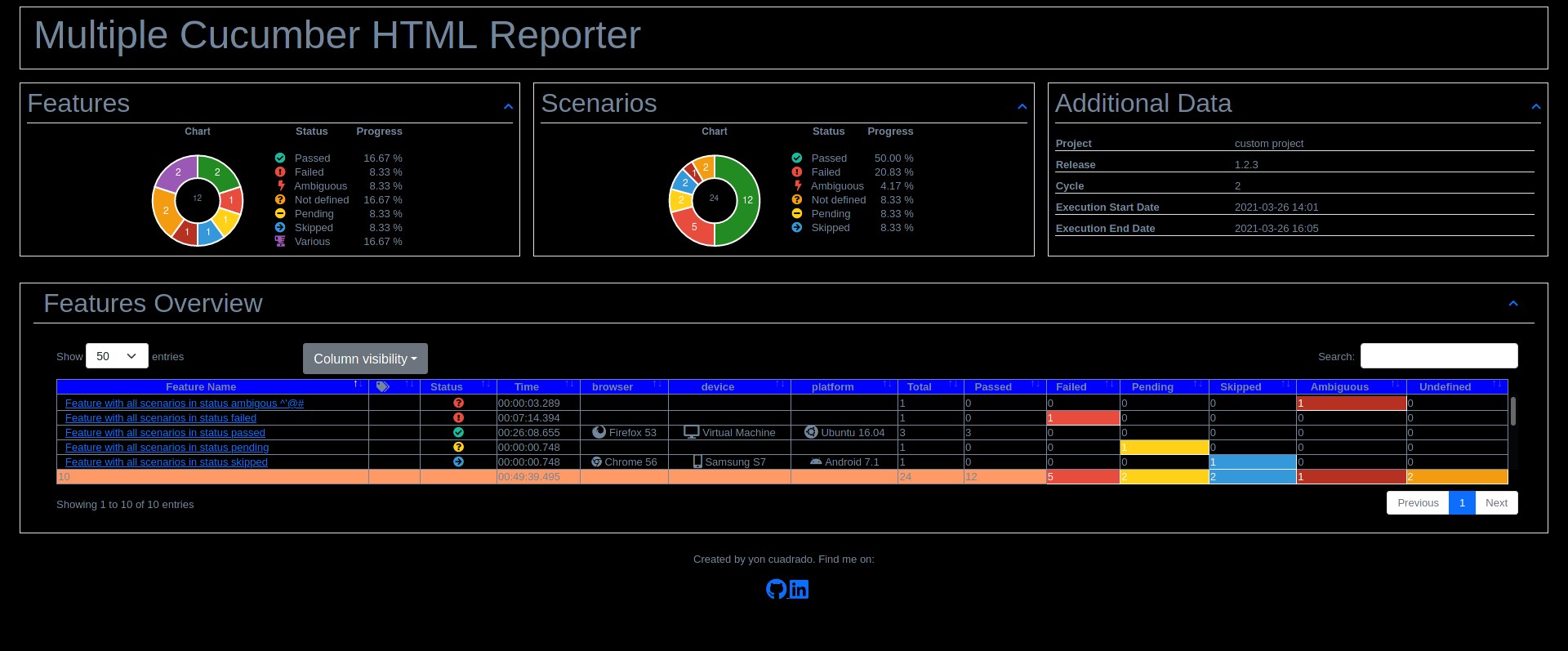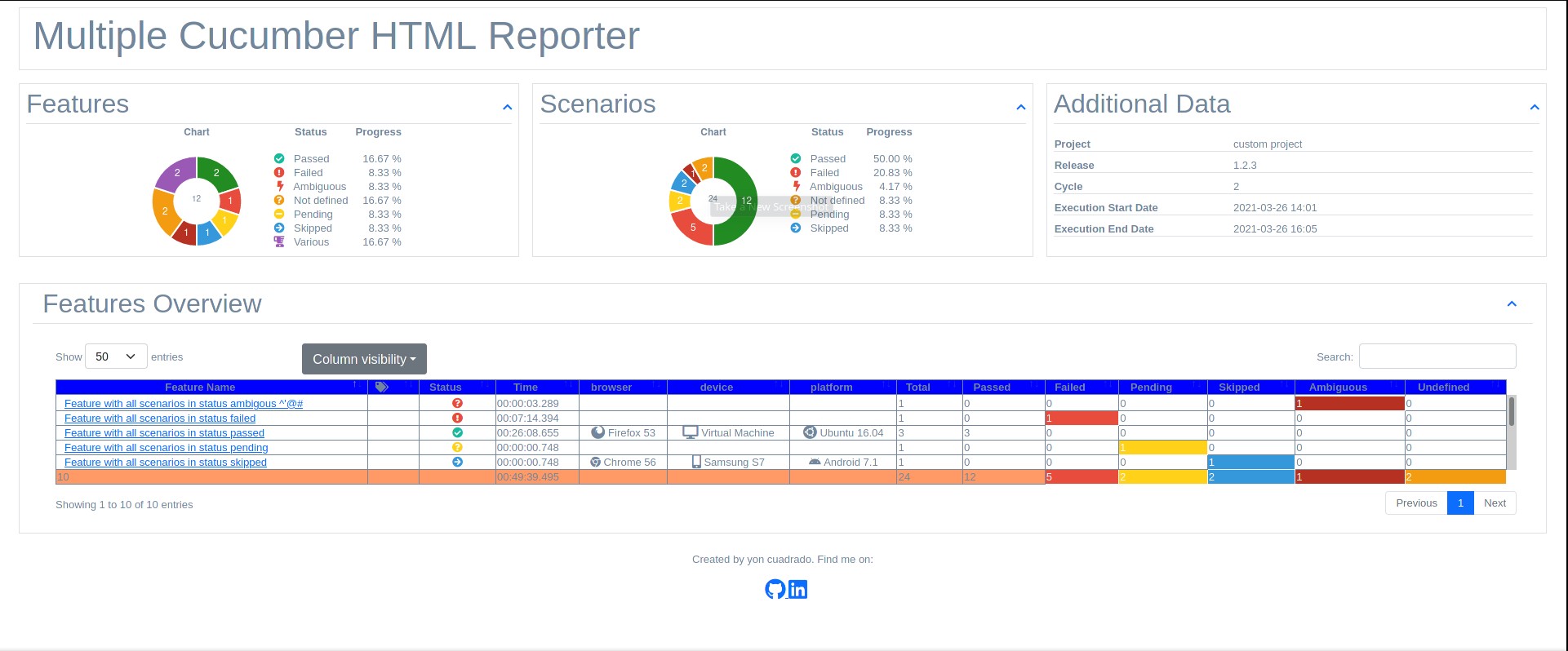wdio-cucumber-html-reporter
A WDIO reporter that creates an html report using the plugin cucumber-html-report-generator. This plugin has been created from the project multiple-cucumber-html-reporter. The main differences with that project are these:
- written with typescript
- option to display Outline scenarios in a grouped way
- Option to store the reports in a mongodb database and access them from a web page
- Dark and light themes
A sample with dark theme and report metadata can be found here and a sample with light theme and report metadata can be found here
And a sample with dark theme without report metadata can be found here and a sample with light theme without report metadata can be found here
THIS MODULE CAN ONLY WORK WITH WebdriverIO V7+!\
What does it do
This reporter will generate an html file using the plugin
It will also add metadata about the running instance to the feature file and last but not least, it will give you the opportunity to add attachments to the JSON output.
Installation
The easiest way is to keep wdio-cucumber-html-reporter as a devDependency in your package.json.
You can simple do it by:
npm install wdio-cucumber-html-reporter --save-devso it will automatically be added to your package.json
Instructions on how to install WebdriverIO can be found here.
Configuration
This reporter first generates the json files with the results of the execution. Configure the output directory and the language in your wdio.conf.js file:
exports.config = {
// ...
reporters: [
// Like this with the default options, see the options below
CucumberHtmlReporter,
// OR like this if you want to set the folder and the language
[ CucumberHtmlReporter, {
jsonFolder: '.tmp/new/',
language: 'en',
},
],
],
// ...Options
jsonFolder
- Type:
String - Mandatory: No
- Default:
.tmp/json/
The directory where the JSON files, generated by this report, will be stored, relative from where the script is started.
N.B.: If you use a npm script from the command line, like for example npm run test the jsonFolder will be relative from the path
where the script is executed. Executing it from the root of your project will also create the jsonFolder in the root of you project.
language
- Type:
String - Mandatory: No
- Default:
en
The language in which the Gherkin scenarios are written (defaults to English). The list of language codes and its keywords can be found here.
and then in the onComplete hook the html report is generated.The options of the generateHtmlReport method are described in the documentation of the cucumber-html-report-generator doc plugin
onComplete: async (): Promise<void> => {
await CucumberHtmlJsonReporter.generateHtmlReport({
jsonDir: `${path.resolve( './' )}/.tmp/json/`,
})
},
}
Metadata
This report can automatically store the metadata of the current machine / device the feature has been executed on.
To customize this you can add the following object to your capabilities
// Example wdio.conf.js
exports.config = {
//..
capabilities: [
{
browserName: 'chrome',
// Add this
'cjson:metadata': {
// For a browser
browser: {
name: 'chrome',
version: '58',
},
// for an app
app: {
name: 'name.of.app.ipa',
version: '1.2.3',
},
device: 'MacBook Pro 15',
platform: {
name: 'OSX',
version: '10.12.6'
}
},
},
],
};Metadata values
metadata.app.name
- Type:
string
e.g.: The name of the app.
metadata.app.version
- Type:
string
e.g.: The version of the app.
metadata.browser.name
- Type:
string - Possible values:
internet explorer | edge | chrome | firefox | safari
metadata.browser.version
- Type:
string
e.g.: The version of the browser, this can be added manual or retrieved during the execution of the tests to get the exact version number.
metadata.device
- Type:
string
e.g.: A name that represents the type of device. For example, if you run it on a virtual machine, you can place it here Virtual Machine,
or the name of the mobile, like for example iPhone 7 Plus.
metadata.platform.name
- Type:
string - Possible values:
windows | osx | linux | ubuntu | android | ios
metadata.platform.version
- Type:
string
e.g.: The version of the platform
If you don't provide the
browser-object in the metadata, this module will automatically determine it for you. It will always override it with the most recent value it can determine.
If you don't provide the
deviceand or theplatform-object it will be defaulted for you tonot known
If you don't provide a
browser.nameor abrowser.versionthe module will try to determine this automatically.
Attachment
You have the option to attach data to the JSON file in all these hooks / steps:
- Before(All)
- After(All)
- Given
- When
- Then
- And
The only thing you need to provide is the following code in your step files.
import CucumberHtmlReporter from 'wdio-cucumber-html-reporter';
// Attach a string (if no type is provided it will automatically default to `text/plain`
CucumberHtmlReporter.attach('just a string');
CucumberHtmlReporter.attach('just a second string', 'text/plain');
// Attach JSON
CucumberHtmlReporter.attach({"json-string": true}, 'application/json');
// Attach a screenshot in a before hook
CucumberHtmlReporter.attach(browser.takeScreenshot(), 'image/png');Project example
I have created a project where this report is used: webdriverio-cucumber-typescript.




